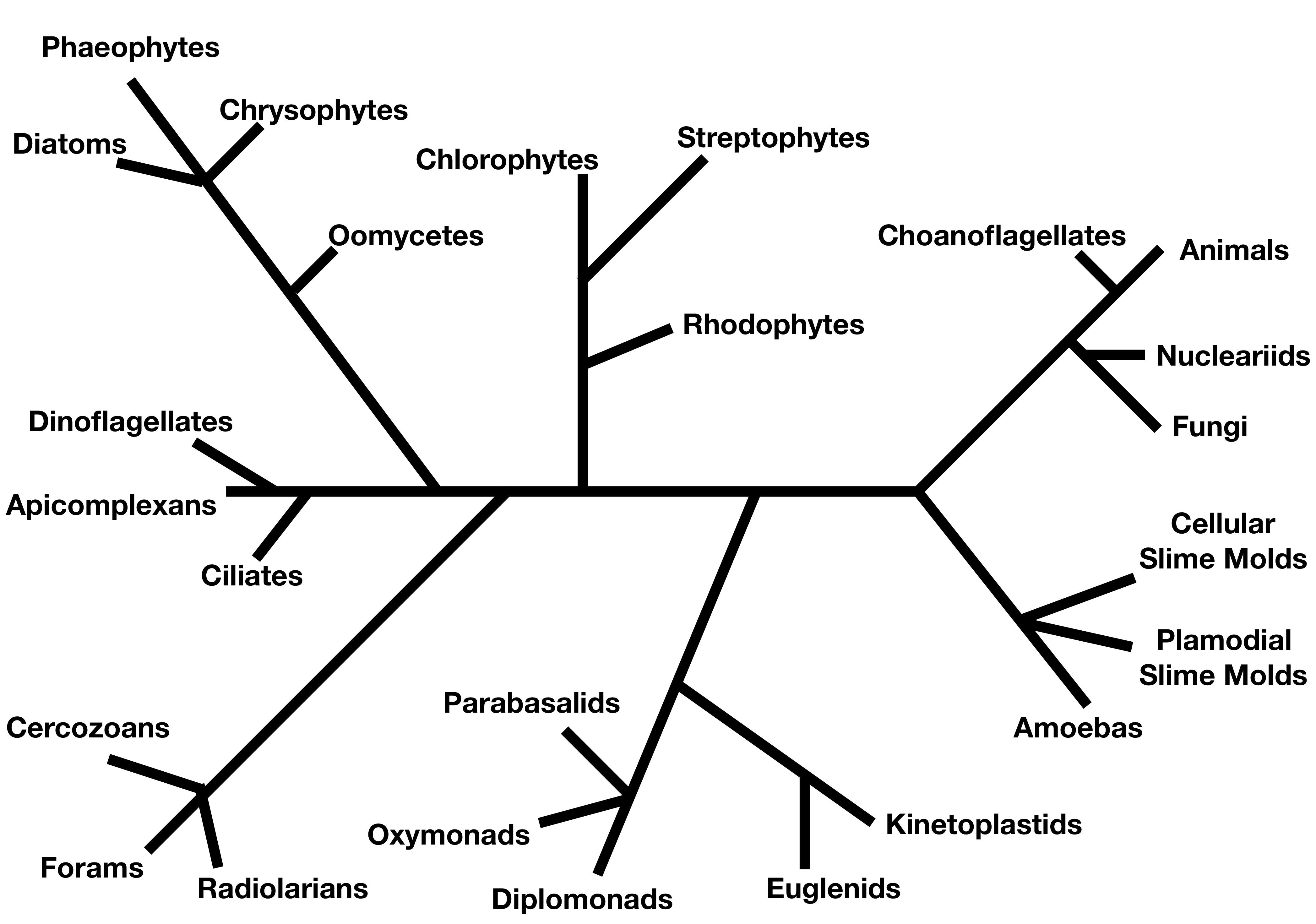Eukaryotic Evolution
Eukaryotes evolved from prokaryotes. The earliest eukaryotic fossils (probably) date to about 2.1 billion years ago. However, there is geochemical evidence that eukaryotes may have existed long before, perhaps as early as 2.7 billion years ago, although the exact date is an open question.
Eukaryotic cells are generally larger and more complex than prokaryotic cells. Structures unique to eukaryotes include the nucleus, the endomembrane system, a complex cytoskeleton, and organelles specialized for energy transformations, e.g., mitochondria and plastids. Infoldings of the plasma membrane probably gave rise to the membrane-bound organelles of today’s eukaryotic cells.
The organelles of energy transformation have a different origin, however – prokaryotic cells. Sequencing of the mitochondrial genome indicates that mitochondria are derived from alphaproteobacteria. The presence of mitochondria is one of the many synapomorphies of eukaryotes, as all eukaryotic groups have (or had) mitochondria. Plastids, such as chloroplasts, originated from cyanobacteria, and are present in only some eukaryotic lineages.
Eukaryotes quickly radiated into a number of different groups. Eukaryotes were originally classified as either animals or plants, and all other eukaryotes, including fungi, amoebas, algae, etc. were sorted into one of these two groups. Fungi were eventually reclassified into their own kingdom, and organisms that did not fit neatly into one of these three kingdoms were called ‘protists.’ Some older textbooks, in fact, still refer to “Kingdom Protista”. We know now, from molecular analysis, that this classification scheme is not appropriate to describe the vast diversity of eukaryotes. “Kingdom Protista” is not monophyletic and therefore not a valid clade.
Currently, most eukaryotes are classified in one of five supergroups – Excavata, SAR, Archaeplastida, Amoebozoa, and Opisthokonta. There are also some taxa that do not seem to fit into any of these groups, or whose place in eukaryotic phylogeny is unclear. Eukaryote phylogeny is still very much a work in progress, and substantial revisions might still be made. The supergroups used in this lab manual are:
- Excavata – includes (mostly) unicellular, flagellated, heterotrophs (= zooflagellates). This supergroup includes two lineages, united primarily by molecular traits. Each of these includes two main clades:
- Metamonads
- o Diplomonads
- o Parabasalids
- o Oxymonads
- Euglenozoans
- o Kinetoplastids
- o Euglenids
- Amoebozoa – includes organisms that have a stage in their life cycle that is unicellular, lacks a cell wall, and moves or feeds by lobose pseudopodia. There is molecular evidence that this group is a sister group to the Opisthokonta.
- Amoebae
- Plasmodial Slime Molds
- Cellular Slime Molds
- Opisthokonta – diverse group of heterotrophic organisms that includes the fungi and animals
- Archaeplastida – includes the evolutionary lineage that acquired plastids through primary endosymbiosis with a cyanobacterium. The plant kingom “nests” within this clade. Non-plant members of the Archaeplastida are commonly referred to as algae (as are some members of supergroup SAR). Major clades include:
- Rhodophyta – red algae
- Viridiplantae
- o Chlorophyta – green algae
- o Streptophyta
- Charophyta – charophytes
- Plantae – land plants (embryophytes)
- SAR (Stramenopiles, Alveolates, and Rhizarians). This grouping includes a diverse array of phyla that have been united on the basis of molecular data. (Older textbooks combine the stramenopiles and alveolates in the supergroup Chromalveolata and maintains the Rhizaria as a separate supergroup). Photosynthetic members of this supergroup are commonly referred to as algae, and unicellular heterotrophs in this group as protozoans.
- Stramenopiles
- o Oomycetes – water molds
- o Bacillariophyta – diatoms
- o Chrysophyta – golden algae
- o Phaeophyta – brown algae
- Alveolates
- o Ciliophora – ciliates
- o Dinoflagellata – dinoflagellates
- o Apicomplexa – apicomplexans
- Rhizarians
- o Foraminifera – forams, foraminiferans
- o Radiolaria – radiolarians
- o Cercozoa – cercozoans
This figure presents the most recent picture of eukaryote evolution, but keep in mind that it is hypothesis.


